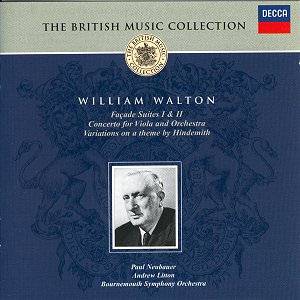 Composer: William Walton
Composer: William Walton
Works: Façade, Suites Nos I & II; Viola Concerto; Variations on a Theme by Hindemith
Performers: Paul Neubauer (viola); Bournemouth Symphony Orchestra; Andrew Litton (conductor)
Recording: March 1996, Guildhall, Southampton
Label: DECCA
The music of Sir William Walton, a titan of 20th-century British composition, is often imbued with a distinctive blend of lyrical grace and rhythmic vigor. This new recording from Decca’s British Music Collection brings together a selection of Walton’s works that highlight his evolution as a composer, particularly as he approached the age of sixty. The inclusion of “Façade” and its orchestral suites alongside the Viola Concerto and the “Variations on a Theme by Hindemith” paints a portrait of a composer who was, by this point in his career, deeply engaged in both the tradition of English music and the broader European avant-garde.
The Bournemouth Symphony Orchestra under Andrew Litton’s direction tackles these works with commendable assurance. The “Variations on a Theme by Hindemith” stands out as one of Walton’s late masterpieces, and the orchestration reveals a confident mastery that belies his age. The variations draw intricately from Hindemith’s Cello Concerto, demonstrating Walton’s ability to weave a rich tapestry of thematic material that is both respectful of the source and uniquely his own. Litton’s interpretation, however, occasionally leans towards the cautious; moments that could benefit from a more daring orchestral flair seem slightly restrained. The orchestra plays with a polished yet somewhat reserved character, which may stem from an insufficient familiarity with the repertoire.
Paul Neubauer’s performance in the Viola Concerto is a highlight of this recording. His agile approach captures the work’s inherent tension and lyrical beauty. The balance with the orchestra is particularly well-executed, allowing Neubauer’s nuances to shine without overshadowing the ensemble’s contributions. The ebb and flow of the music, especially in the slower sections, is rendered with a sensitivity that speaks to both the technical prowess of the soloist and the responsive nature of the orchestra. Nevertheless, when compared to other eminent recordings, such as Nigel Kennedy’s coupling of the Viola and Violin Concertos, Neubauer’s tonal richness—especially in the more lyrical passages—leaves a slight impression of undernourishment.
The suites extracted from “Façade,” orchestrated by Litton, raise questions about their necessity in this format. While the music contains vibrant moments and showcases the orchestra’s capabilities, the absence of the original narrators diminishes the whimsical and theatrical essence that Walton intended. The suites, devoid of their spoken context, feel somewhat flat, akin to a sandwich lacking its filling; they display a certain charm but ultimately lack the vivacity that the original setting provides.
Recording quality is commendable, with the Guildhall’s acoustics enhancing the overall listening experience. The clarity and depth of the orchestral sound are particularly notable, allowing the intricate dialogues between instruments to emerge beautifully. However, the accompanying booklet is a missed opportunity, as it suffers from poor layout choices that detract from the overall presentation of this collection.
The combination of these works offers a compelling glimpse into Walton’s versatility and rich musical language. While the performances are solid, they occasionally lack the dynamism necessary to elevate Walton’s music to its fullest potential. The recording serves as an admirable homage to one of Britain’s most significant composers, though it may not entirely satisfy those seeking the vibrancy and wit that Walton’s music can evoke when performed with greater abandon. The disc merits attention, particularly for its central works, but it ultimately leaves one hoping for a more audacious interpretation that fully captures the essence of Walton’s genius.



